Reflective Essay on Organizational Control and Employee Motivation
VerifiedAdded on 2023/04/21
|10
|2640
|86
Essay
AI Summary
This essay delves into the critical aspects of organizational control, examining two primary frameworks: bureaucratic control and cultural control. Bureaucratic control, as discussed, emphasizes the importance of rules, procedures, and hierarchical structures, drawing upon theories from Max Weber and Ludwig von Mises, with practical examples and personal reflections on its benefits, challenges, and weaknesses. Cultural control is also explored, highlighting the influence of organizational culture on employee behavior and motivation, with similarities and dissimilarities from bureaucratic control, along with real-world examples, personal experiences, and an analysis of its strengths and weaknesses. The essay further analyzes the concept of motivation, referencing Stuart Pritchard's work, and discusses various motivation theories, including those of Carl Jung, Maslow, McGregor, and Herzberg, providing insights into how these theories shape management practices and employee engagement. The essay also examines the role of motivation in achieving organizational goals and the impact of managerial assumptions on employee behavior.
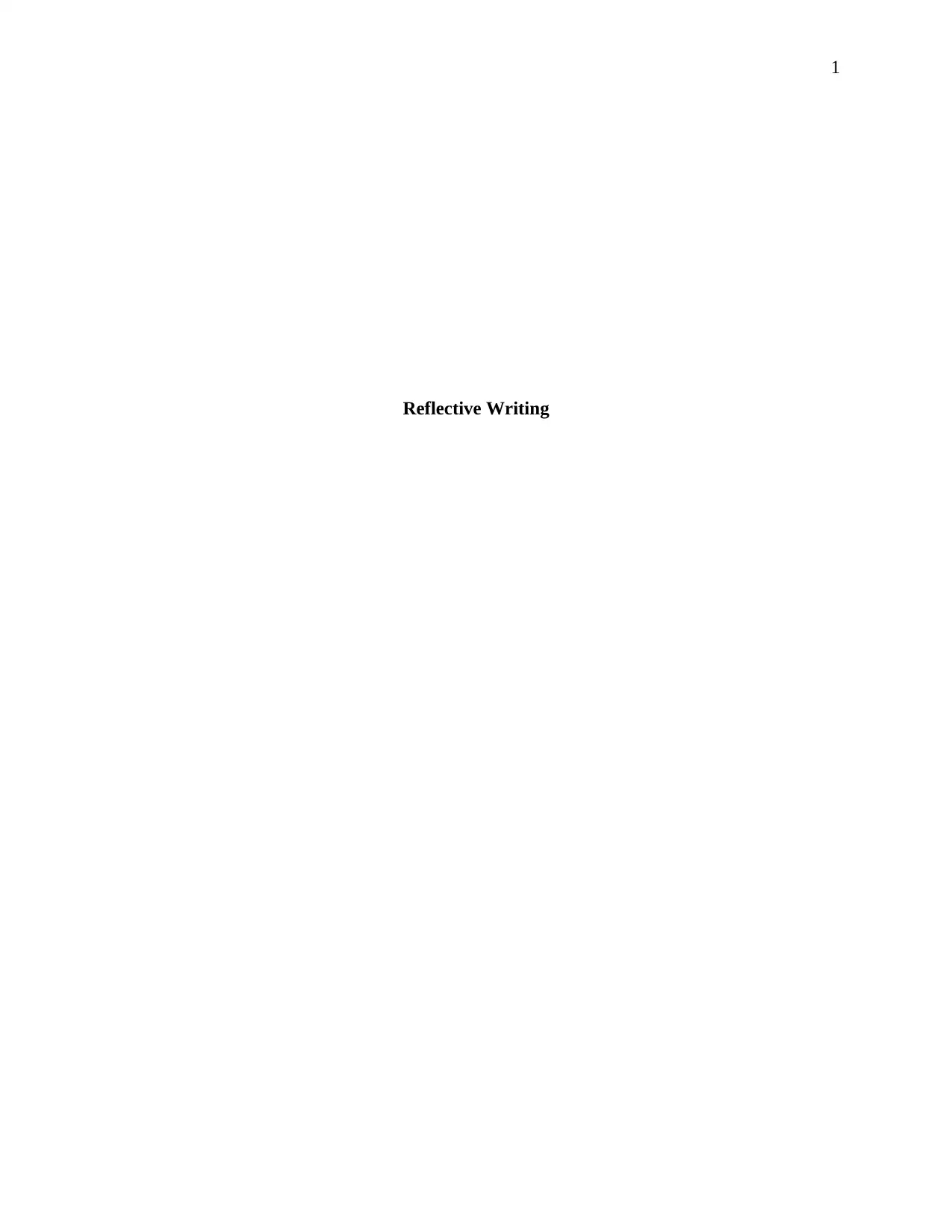
1
Reflective Writing
Reflective Writing
Paraphrase This Document
Need a fresh take? Get an instant paraphrase of this document with our AI Paraphraser
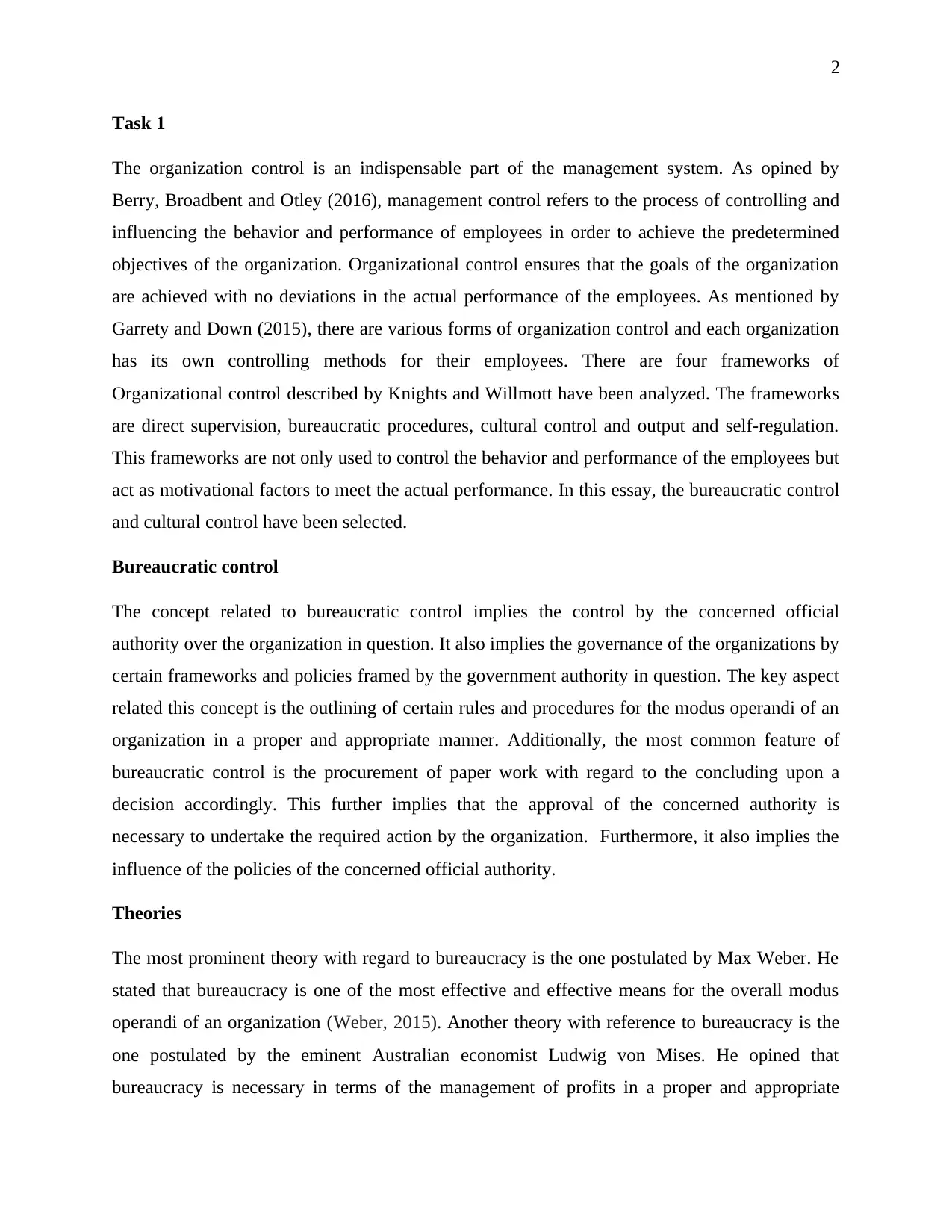
2
Task 1
The organization control is an indispensable part of the management system. As opined by
Berry, Broadbent and Otley (2016), management control refers to the process of controlling and
influencing the behavior and performance of employees in order to achieve the predetermined
objectives of the organization. Organizational control ensures that the goals of the organization
are achieved with no deviations in the actual performance of the employees. As mentioned by
Garrety and Down (2015), there are various forms of organization control and each organization
has its own controlling methods for their employees. There are four frameworks of
Organizational control described by Knights and Willmott have been analyzed. The frameworks
are direct supervision, bureaucratic procedures, cultural control and output and self-regulation.
This frameworks are not only used to control the behavior and performance of the employees but
act as motivational factors to meet the actual performance. In this essay, the bureaucratic control
and cultural control have been selected.
Bureaucratic control
The concept related to bureaucratic control implies the control by the concerned official
authority over the organization in question. It also implies the governance of the organizations by
certain frameworks and policies framed by the government authority in question. The key aspect
related this concept is the outlining of certain rules and procedures for the modus operandi of an
organization in a proper and appropriate manner. Additionally, the most common feature of
bureaucratic control is the procurement of paper work with regard to the concluding upon a
decision accordingly. This further implies that the approval of the concerned authority is
necessary to undertake the required action by the organization. Furthermore, it also implies the
influence of the policies of the concerned official authority.
Theories
The most prominent theory with regard to bureaucracy is the one postulated by Max Weber. He
stated that bureaucracy is one of the most effective and effective means for the overall modus
operandi of an organization (Weber, 2015). Another theory with reference to bureaucracy is the
one postulated by the eminent Australian economist Ludwig von Mises. He opined that
bureaucracy is necessary in terms of the management of profits in a proper and appropriate
Task 1
The organization control is an indispensable part of the management system. As opined by
Berry, Broadbent and Otley (2016), management control refers to the process of controlling and
influencing the behavior and performance of employees in order to achieve the predetermined
objectives of the organization. Organizational control ensures that the goals of the organization
are achieved with no deviations in the actual performance of the employees. As mentioned by
Garrety and Down (2015), there are various forms of organization control and each organization
has its own controlling methods for their employees. There are four frameworks of
Organizational control described by Knights and Willmott have been analyzed. The frameworks
are direct supervision, bureaucratic procedures, cultural control and output and self-regulation.
This frameworks are not only used to control the behavior and performance of the employees but
act as motivational factors to meet the actual performance. In this essay, the bureaucratic control
and cultural control have been selected.
Bureaucratic control
The concept related to bureaucratic control implies the control by the concerned official
authority over the organization in question. It also implies the governance of the organizations by
certain frameworks and policies framed by the government authority in question. The key aspect
related this concept is the outlining of certain rules and procedures for the modus operandi of an
organization in a proper and appropriate manner. Additionally, the most common feature of
bureaucratic control is the procurement of paper work with regard to the concluding upon a
decision accordingly. This further implies that the approval of the concerned authority is
necessary to undertake the required action by the organization. Furthermore, it also implies the
influence of the policies of the concerned official authority.
Theories
The most prominent theory with regard to bureaucracy is the one postulated by Max Weber. He
stated that bureaucracy is one of the most effective and effective means for the overall modus
operandi of an organization (Weber, 2015). Another theory with reference to bureaucracy is the
one postulated by the eminent Australian economist Ludwig von Mises. He opined that
bureaucracy is necessary in terms of the management of profits in a proper and appropriate
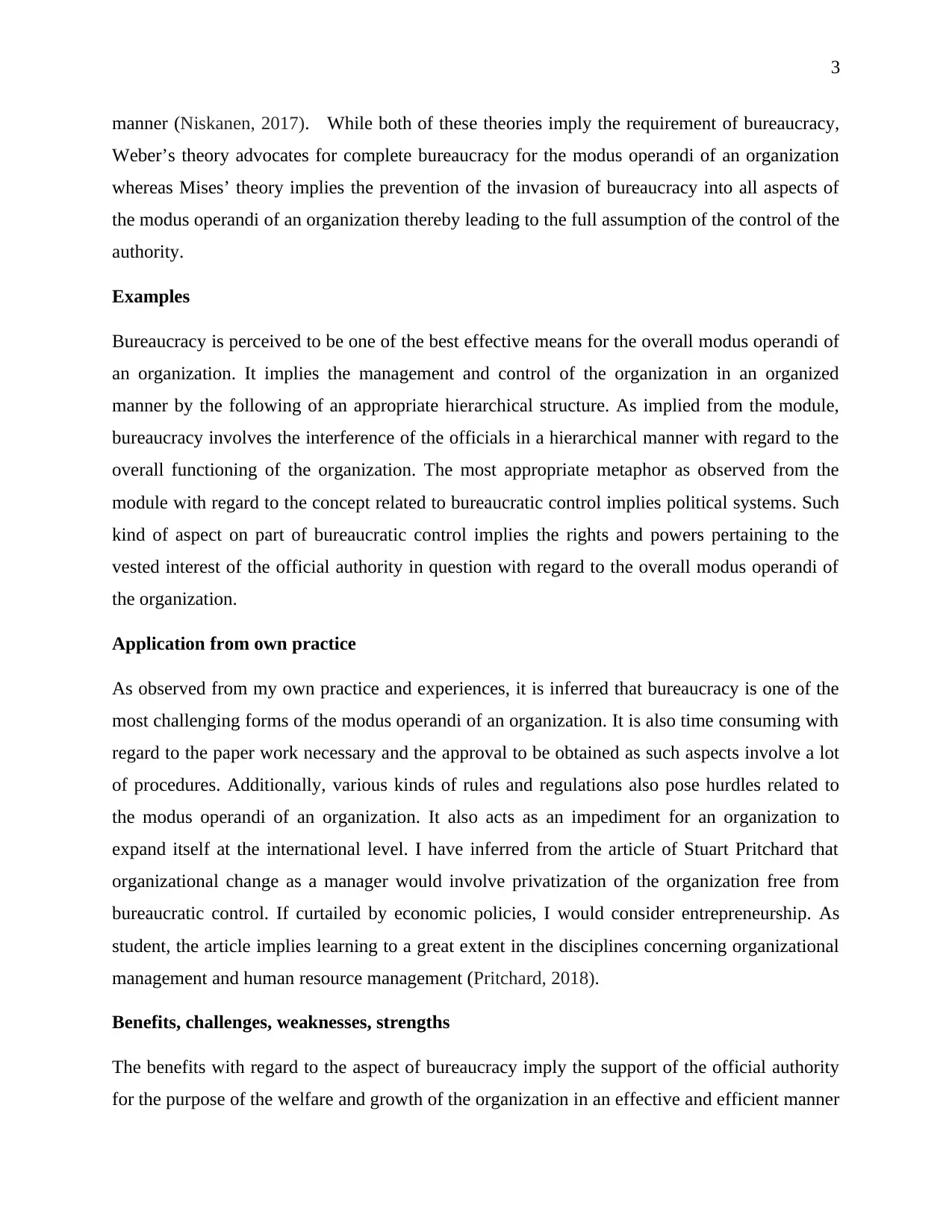
3
manner (Niskanen, 2017). While both of these theories imply the requirement of bureaucracy,
Weber’s theory advocates for complete bureaucracy for the modus operandi of an organization
whereas Mises’ theory implies the prevention of the invasion of bureaucracy into all aspects of
the modus operandi of an organization thereby leading to the full assumption of the control of the
authority.
Examples
Bureaucracy is perceived to be one of the best effective means for the overall modus operandi of
an organization. It implies the management and control of the organization in an organized
manner by the following of an appropriate hierarchical structure. As implied from the module,
bureaucracy involves the interference of the officials in a hierarchical manner with regard to the
overall functioning of the organization. The most appropriate metaphor as observed from the
module with regard to the concept related to bureaucratic control implies political systems. Such
kind of aspect on part of bureaucratic control implies the rights and powers pertaining to the
vested interest of the official authority in question with regard to the overall modus operandi of
the organization.
Application from own practice
As observed from my own practice and experiences, it is inferred that bureaucracy is one of the
most challenging forms of the modus operandi of an organization. It is also time consuming with
regard to the paper work necessary and the approval to be obtained as such aspects involve a lot
of procedures. Additionally, various kinds of rules and regulations also pose hurdles related to
the modus operandi of an organization. It also acts as an impediment for an organization to
expand itself at the international level. I have inferred from the article of Stuart Pritchard that
organizational change as a manager would involve privatization of the organization free from
bureaucratic control. If curtailed by economic policies, I would consider entrepreneurship. As
student, the article implies learning to a great extent in the disciplines concerning organizational
management and human resource management (Pritchard, 2018).
Benefits, challenges, weaknesses, strengths
The benefits with regard to the aspect of bureaucracy imply the support of the official authority
for the purpose of the welfare and growth of the organization in an effective and efficient manner
manner (Niskanen, 2017). While both of these theories imply the requirement of bureaucracy,
Weber’s theory advocates for complete bureaucracy for the modus operandi of an organization
whereas Mises’ theory implies the prevention of the invasion of bureaucracy into all aspects of
the modus operandi of an organization thereby leading to the full assumption of the control of the
authority.
Examples
Bureaucracy is perceived to be one of the best effective means for the overall modus operandi of
an organization. It implies the management and control of the organization in an organized
manner by the following of an appropriate hierarchical structure. As implied from the module,
bureaucracy involves the interference of the officials in a hierarchical manner with regard to the
overall functioning of the organization. The most appropriate metaphor as observed from the
module with regard to the concept related to bureaucratic control implies political systems. Such
kind of aspect on part of bureaucratic control implies the rights and powers pertaining to the
vested interest of the official authority in question with regard to the overall modus operandi of
the organization.
Application from own practice
As observed from my own practice and experiences, it is inferred that bureaucracy is one of the
most challenging forms of the modus operandi of an organization. It is also time consuming with
regard to the paper work necessary and the approval to be obtained as such aspects involve a lot
of procedures. Additionally, various kinds of rules and regulations also pose hurdles related to
the modus operandi of an organization. It also acts as an impediment for an organization to
expand itself at the international level. I have inferred from the article of Stuart Pritchard that
organizational change as a manager would involve privatization of the organization free from
bureaucratic control. If curtailed by economic policies, I would consider entrepreneurship. As
student, the article implies learning to a great extent in the disciplines concerning organizational
management and human resource management (Pritchard, 2018).
Benefits, challenges, weaknesses, strengths
The benefits with regard to the aspect of bureaucracy imply the support of the official authority
for the purpose of the welfare and growth of the organization in an effective and efficient manner
⊘ This is a preview!⊘
Do you want full access?
Subscribe today to unlock all pages.

Trusted by 1+ million students worldwide
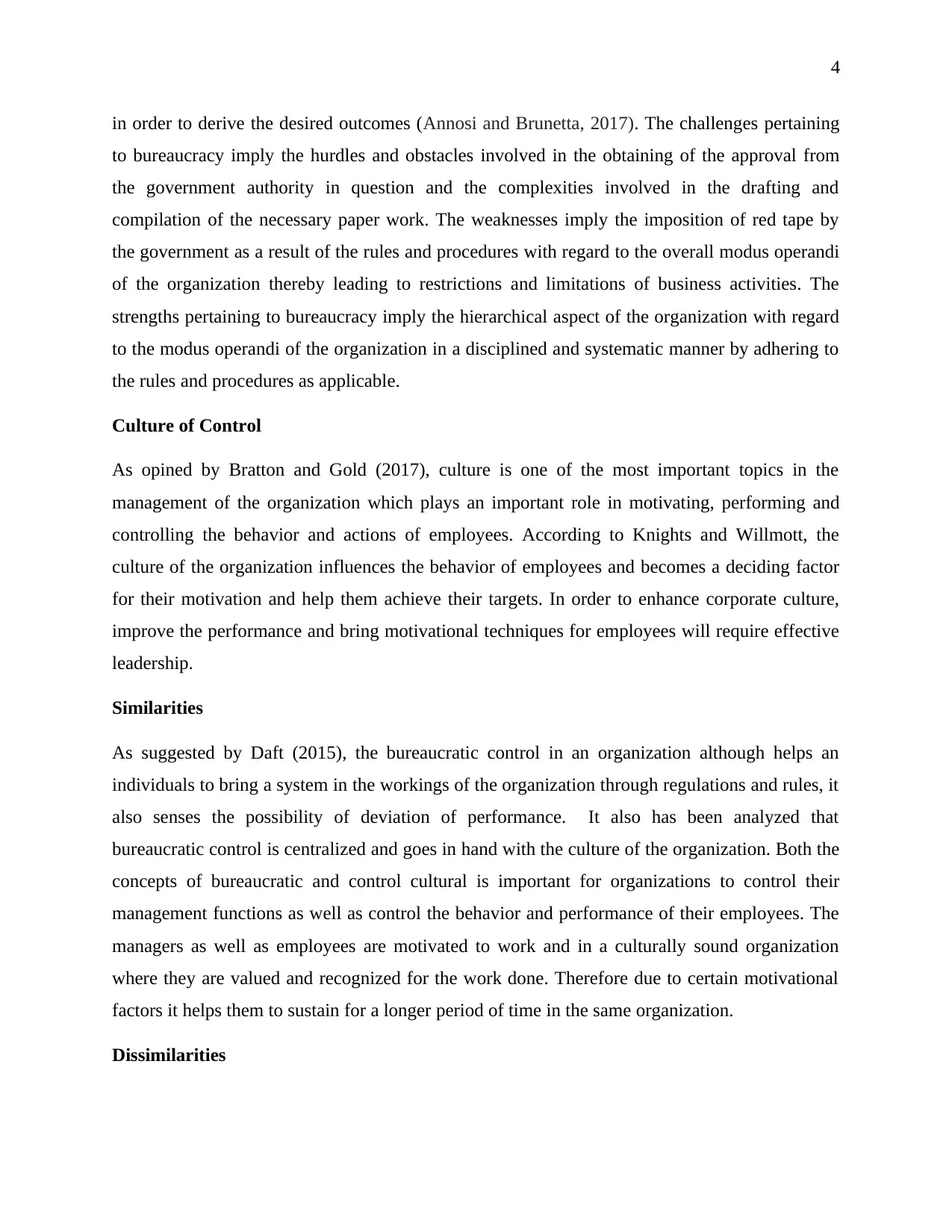
4
in order to derive the desired outcomes (Annosi and Brunetta, 2017). The challenges pertaining
to bureaucracy imply the hurdles and obstacles involved in the obtaining of the approval from
the government authority in question and the complexities involved in the drafting and
compilation of the necessary paper work. The weaknesses imply the imposition of red tape by
the government as a result of the rules and procedures with regard to the overall modus operandi
of the organization thereby leading to restrictions and limitations of business activities. The
strengths pertaining to bureaucracy imply the hierarchical aspect of the organization with regard
to the modus operandi of the organization in a disciplined and systematic manner by adhering to
the rules and procedures as applicable.
Culture of Control
As opined by Bratton and Gold (2017), culture is one of the most important topics in the
management of the organization which plays an important role in motivating, performing and
controlling the behavior and actions of employees. According to Knights and Willmott, the
culture of the organization influences the behavior of employees and becomes a deciding factor
for their motivation and help them achieve their targets. In order to enhance corporate culture,
improve the performance and bring motivational techniques for employees will require effective
leadership.
Similarities
As suggested by Daft (2015), the bureaucratic control in an organization although helps an
individuals to bring a system in the workings of the organization through regulations and rules, it
also senses the possibility of deviation of performance. It also has been analyzed that
bureaucratic control is centralized and goes in hand with the culture of the organization. Both the
concepts of bureaucratic and control cultural is important for organizations to control their
management functions as well as control the behavior and performance of their employees. The
managers as well as employees are motivated to work and in a culturally sound organization
where they are valued and recognized for the work done. Therefore due to certain motivational
factors it helps them to sustain for a longer period of time in the same organization.
Dissimilarities
in order to derive the desired outcomes (Annosi and Brunetta, 2017). The challenges pertaining
to bureaucracy imply the hurdles and obstacles involved in the obtaining of the approval from
the government authority in question and the complexities involved in the drafting and
compilation of the necessary paper work. The weaknesses imply the imposition of red tape by
the government as a result of the rules and procedures with regard to the overall modus operandi
of the organization thereby leading to restrictions and limitations of business activities. The
strengths pertaining to bureaucracy imply the hierarchical aspect of the organization with regard
to the modus operandi of the organization in a disciplined and systematic manner by adhering to
the rules and procedures as applicable.
Culture of Control
As opined by Bratton and Gold (2017), culture is one of the most important topics in the
management of the organization which plays an important role in motivating, performing and
controlling the behavior and actions of employees. According to Knights and Willmott, the
culture of the organization influences the behavior of employees and becomes a deciding factor
for their motivation and help them achieve their targets. In order to enhance corporate culture,
improve the performance and bring motivational techniques for employees will require effective
leadership.
Similarities
As suggested by Daft (2015), the bureaucratic control in an organization although helps an
individuals to bring a system in the workings of the organization through regulations and rules, it
also senses the possibility of deviation of performance. It also has been analyzed that
bureaucratic control is centralized and goes in hand with the culture of the organization. Both the
concepts of bureaucratic and control cultural is important for organizations to control their
management functions as well as control the behavior and performance of their employees. The
managers as well as employees are motivated to work and in a culturally sound organization
where they are valued and recognized for the work done. Therefore due to certain motivational
factors it helps them to sustain for a longer period of time in the same organization.
Dissimilarities
Paraphrase This Document
Need a fresh take? Get an instant paraphrase of this document with our AI Paraphraser
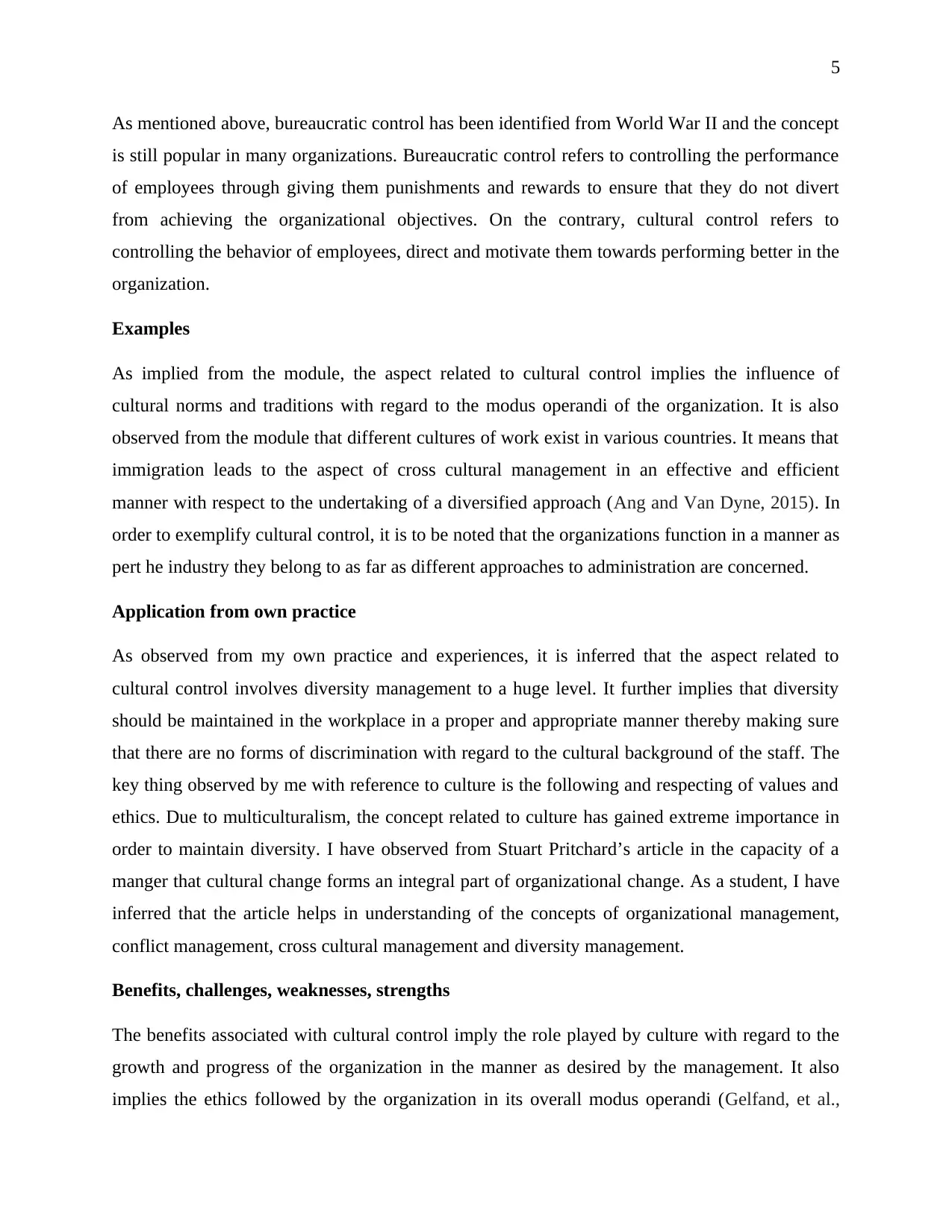
5
As mentioned above, bureaucratic control has been identified from World War II and the concept
is still popular in many organizations. Bureaucratic control refers to controlling the performance
of employees through giving them punishments and rewards to ensure that they do not divert
from achieving the organizational objectives. On the contrary, cultural control refers to
controlling the behavior of employees, direct and motivate them towards performing better in the
organization.
Examples
As implied from the module, the aspect related to cultural control implies the influence of
cultural norms and traditions with regard to the modus operandi of the organization. It is also
observed from the module that different cultures of work exist in various countries. It means that
immigration leads to the aspect of cross cultural management in an effective and efficient
manner with respect to the undertaking of a diversified approach (Ang and Van Dyne, 2015). In
order to exemplify cultural control, it is to be noted that the organizations function in a manner as
pert he industry they belong to as far as different approaches to administration are concerned.
Application from own practice
As observed from my own practice and experiences, it is inferred that the aspect related to
cultural control involves diversity management to a huge level. It further implies that diversity
should be maintained in the workplace in a proper and appropriate manner thereby making sure
that there are no forms of discrimination with regard to the cultural background of the staff. The
key thing observed by me with reference to culture is the following and respecting of values and
ethics. Due to multiculturalism, the concept related to culture has gained extreme importance in
order to maintain diversity. I have observed from Stuart Pritchard’s article in the capacity of a
manger that cultural change forms an integral part of organizational change. As a student, I have
inferred that the article helps in understanding of the concepts of organizational management,
conflict management, cross cultural management and diversity management.
Benefits, challenges, weaknesses, strengths
The benefits associated with cultural control imply the role played by culture with regard to the
growth and progress of the organization in the manner as desired by the management. It also
implies the ethics followed by the organization in its overall modus operandi (Gelfand, et al.,
As mentioned above, bureaucratic control has been identified from World War II and the concept
is still popular in many organizations. Bureaucratic control refers to controlling the performance
of employees through giving them punishments and rewards to ensure that they do not divert
from achieving the organizational objectives. On the contrary, cultural control refers to
controlling the behavior of employees, direct and motivate them towards performing better in the
organization.
Examples
As implied from the module, the aspect related to cultural control implies the influence of
cultural norms and traditions with regard to the modus operandi of the organization. It is also
observed from the module that different cultures of work exist in various countries. It means that
immigration leads to the aspect of cross cultural management in an effective and efficient
manner with respect to the undertaking of a diversified approach (Ang and Van Dyne, 2015). In
order to exemplify cultural control, it is to be noted that the organizations function in a manner as
pert he industry they belong to as far as different approaches to administration are concerned.
Application from own practice
As observed from my own practice and experiences, it is inferred that the aspect related to
cultural control involves diversity management to a huge level. It further implies that diversity
should be maintained in the workplace in a proper and appropriate manner thereby making sure
that there are no forms of discrimination with regard to the cultural background of the staff. The
key thing observed by me with reference to culture is the following and respecting of values and
ethics. Due to multiculturalism, the concept related to culture has gained extreme importance in
order to maintain diversity. I have observed from Stuart Pritchard’s article in the capacity of a
manger that cultural change forms an integral part of organizational change. As a student, I have
inferred that the article helps in understanding of the concepts of organizational management,
conflict management, cross cultural management and diversity management.
Benefits, challenges, weaknesses, strengths
The benefits associated with cultural control imply the role played by culture with regard to the
growth and progress of the organization in the manner as desired by the management. It also
implies the ethics followed by the organization in its overall modus operandi (Gelfand, et al.,
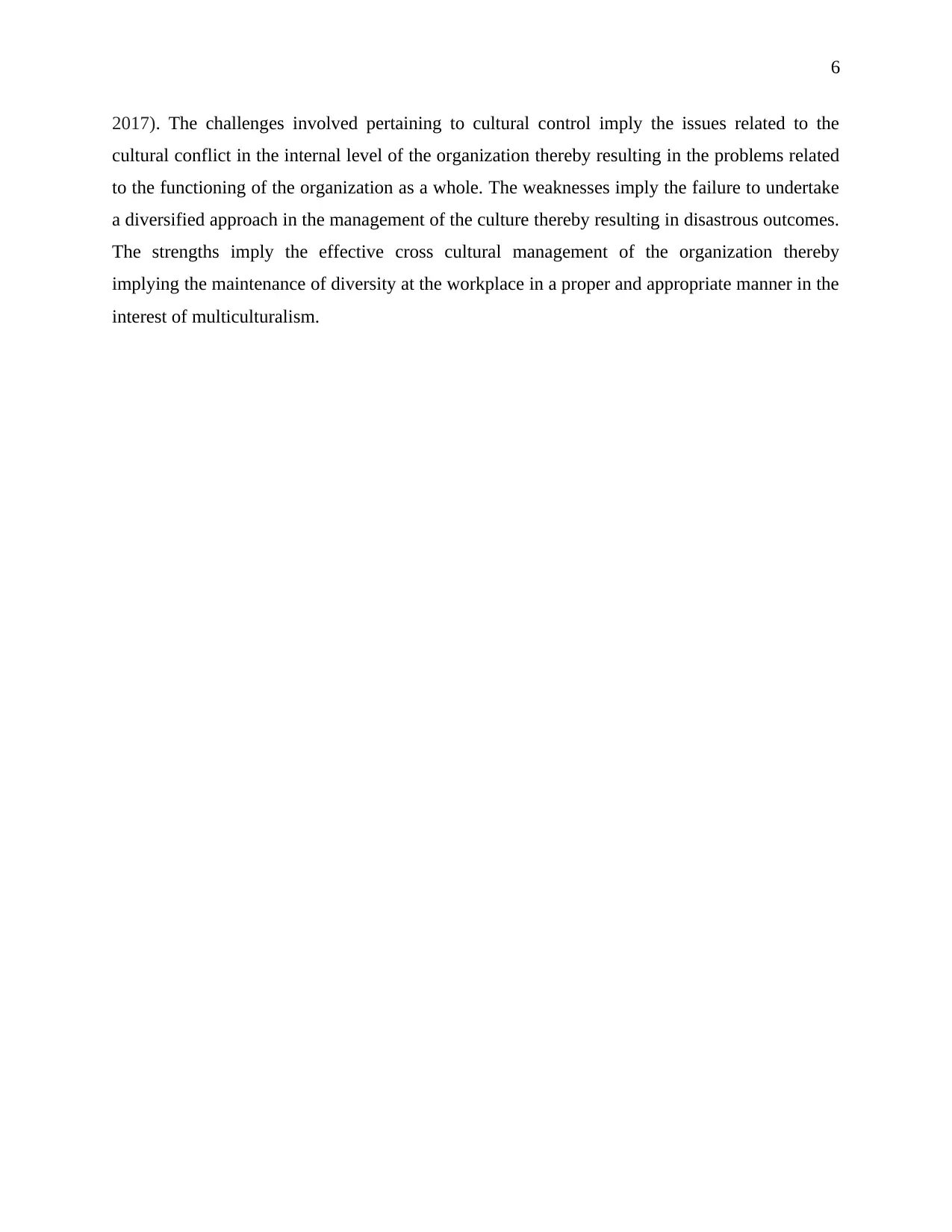
6
2017). The challenges involved pertaining to cultural control imply the issues related to the
cultural conflict in the internal level of the organization thereby resulting in the problems related
to the functioning of the organization as a whole. The weaknesses imply the failure to undertake
a diversified approach in the management of the culture thereby resulting in disastrous outcomes.
The strengths imply the effective cross cultural management of the organization thereby
implying the maintenance of diversity at the workplace in a proper and appropriate manner in the
interest of multiculturalism.
2017). The challenges involved pertaining to cultural control imply the issues related to the
cultural conflict in the internal level of the organization thereby resulting in the problems related
to the functioning of the organization as a whole. The weaknesses imply the failure to undertake
a diversified approach in the management of the culture thereby resulting in disastrous outcomes.
The strengths imply the effective cross cultural management of the organization thereby
implying the maintenance of diversity at the workplace in a proper and appropriate manner in the
interest of multiculturalism.
⊘ This is a preview!⊘
Do you want full access?
Subscribe today to unlock all pages.

Trusted by 1+ million students worldwide
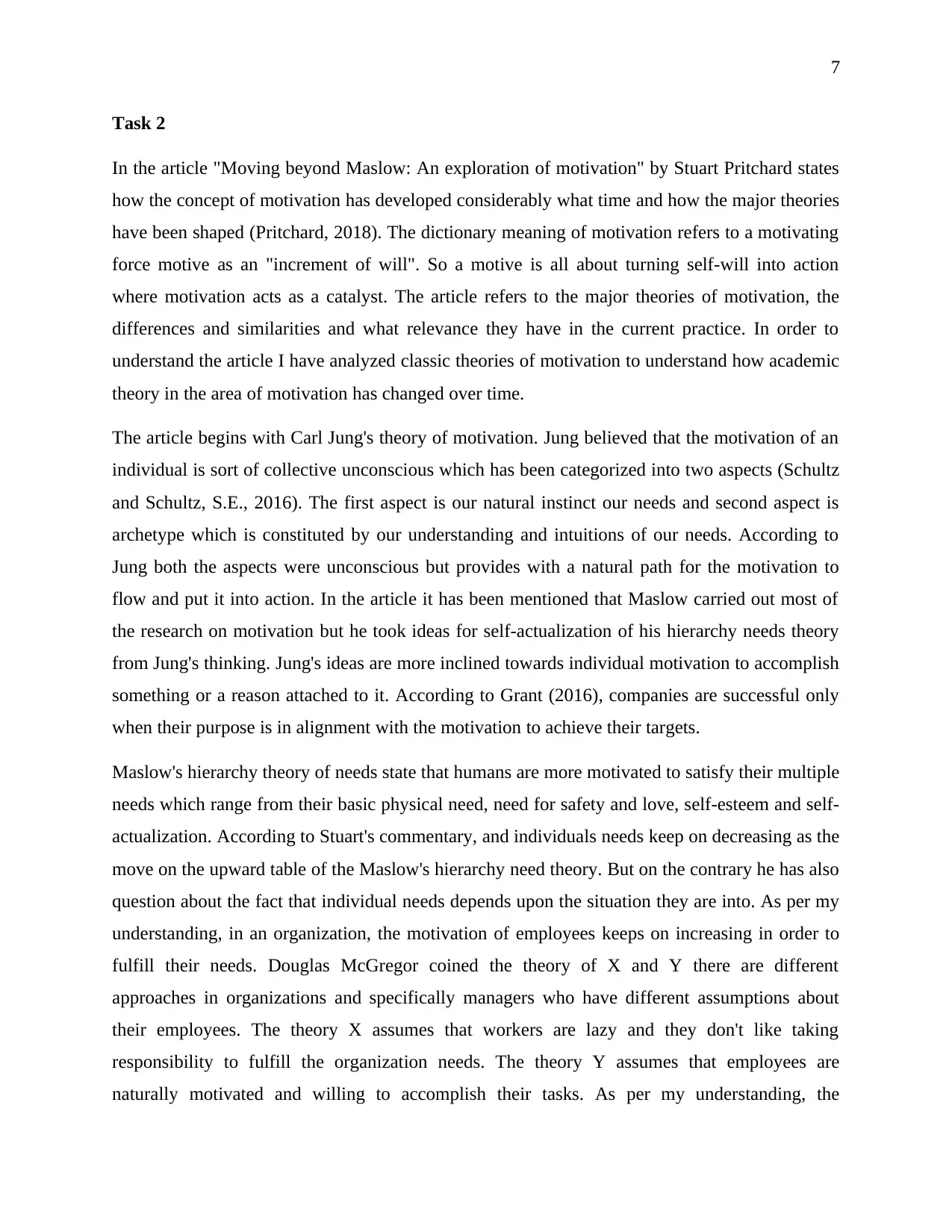
7
Task 2
In the article "Moving beyond Maslow: An exploration of motivation" by Stuart Pritchard states
how the concept of motivation has developed considerably what time and how the major theories
have been shaped (Pritchard, 2018). The dictionary meaning of motivation refers to a motivating
force motive as an "increment of will". So a motive is all about turning self-will into action
where motivation acts as a catalyst. The article refers to the major theories of motivation, the
differences and similarities and what relevance they have in the current practice. In order to
understand the article I have analyzed classic theories of motivation to understand how academic
theory in the area of motivation has changed over time.
The article begins with Carl Jung's theory of motivation. Jung believed that the motivation of an
individual is sort of collective unconscious which has been categorized into two aspects (Schultz
and Schultz, S.E., 2016). The first aspect is our natural instinct our needs and second aspect is
archetype which is constituted by our understanding and intuitions of our needs. According to
Jung both the aspects were unconscious but provides with a natural path for the motivation to
flow and put it into action. In the article it has been mentioned that Maslow carried out most of
the research on motivation but he took ideas for self-actualization of his hierarchy needs theory
from Jung's thinking. Jung's ideas are more inclined towards individual motivation to accomplish
something or a reason attached to it. According to Grant (2016), companies are successful only
when their purpose is in alignment with the motivation to achieve their targets.
Maslow's hierarchy theory of needs state that humans are more motivated to satisfy their multiple
needs which range from their basic physical need, need for safety and love, self-esteem and self-
actualization. According to Stuart's commentary, and individuals needs keep on decreasing as the
move on the upward table of the Maslow's hierarchy need theory. But on the contrary he has also
question about the fact that individual needs depends upon the situation they are into. As per my
understanding, in an organization, the motivation of employees keeps on increasing in order to
fulfill their needs. Douglas McGregor coined the theory of X and Y there are different
approaches in organizations and specifically managers who have different assumptions about
their employees. The theory X assumes that workers are lazy and they don't like taking
responsibility to fulfill the organization needs. The theory Y assumes that employees are
naturally motivated and willing to accomplish their tasks. As per my understanding, the
Task 2
In the article "Moving beyond Maslow: An exploration of motivation" by Stuart Pritchard states
how the concept of motivation has developed considerably what time and how the major theories
have been shaped (Pritchard, 2018). The dictionary meaning of motivation refers to a motivating
force motive as an "increment of will". So a motive is all about turning self-will into action
where motivation acts as a catalyst. The article refers to the major theories of motivation, the
differences and similarities and what relevance they have in the current practice. In order to
understand the article I have analyzed classic theories of motivation to understand how academic
theory in the area of motivation has changed over time.
The article begins with Carl Jung's theory of motivation. Jung believed that the motivation of an
individual is sort of collective unconscious which has been categorized into two aspects (Schultz
and Schultz, S.E., 2016). The first aspect is our natural instinct our needs and second aspect is
archetype which is constituted by our understanding and intuitions of our needs. According to
Jung both the aspects were unconscious but provides with a natural path for the motivation to
flow and put it into action. In the article it has been mentioned that Maslow carried out most of
the research on motivation but he took ideas for self-actualization of his hierarchy needs theory
from Jung's thinking. Jung's ideas are more inclined towards individual motivation to accomplish
something or a reason attached to it. According to Grant (2016), companies are successful only
when their purpose is in alignment with the motivation to achieve their targets.
Maslow's hierarchy theory of needs state that humans are more motivated to satisfy their multiple
needs which range from their basic physical need, need for safety and love, self-esteem and self-
actualization. According to Stuart's commentary, and individuals needs keep on decreasing as the
move on the upward table of the Maslow's hierarchy need theory. But on the contrary he has also
question about the fact that individual needs depends upon the situation they are into. As per my
understanding, in an organization, the motivation of employees keeps on increasing in order to
fulfill their needs. Douglas McGregor coined the theory of X and Y there are different
approaches in organizations and specifically managers who have different assumptions about
their employees. The theory X assumes that workers are lazy and they don't like taking
responsibility to fulfill the organization needs. The theory Y assumes that employees are
naturally motivated and willing to accomplish their tasks. As per my understanding, the
Paraphrase This Document
Need a fresh take? Get an instant paraphrase of this document with our AI Paraphraser
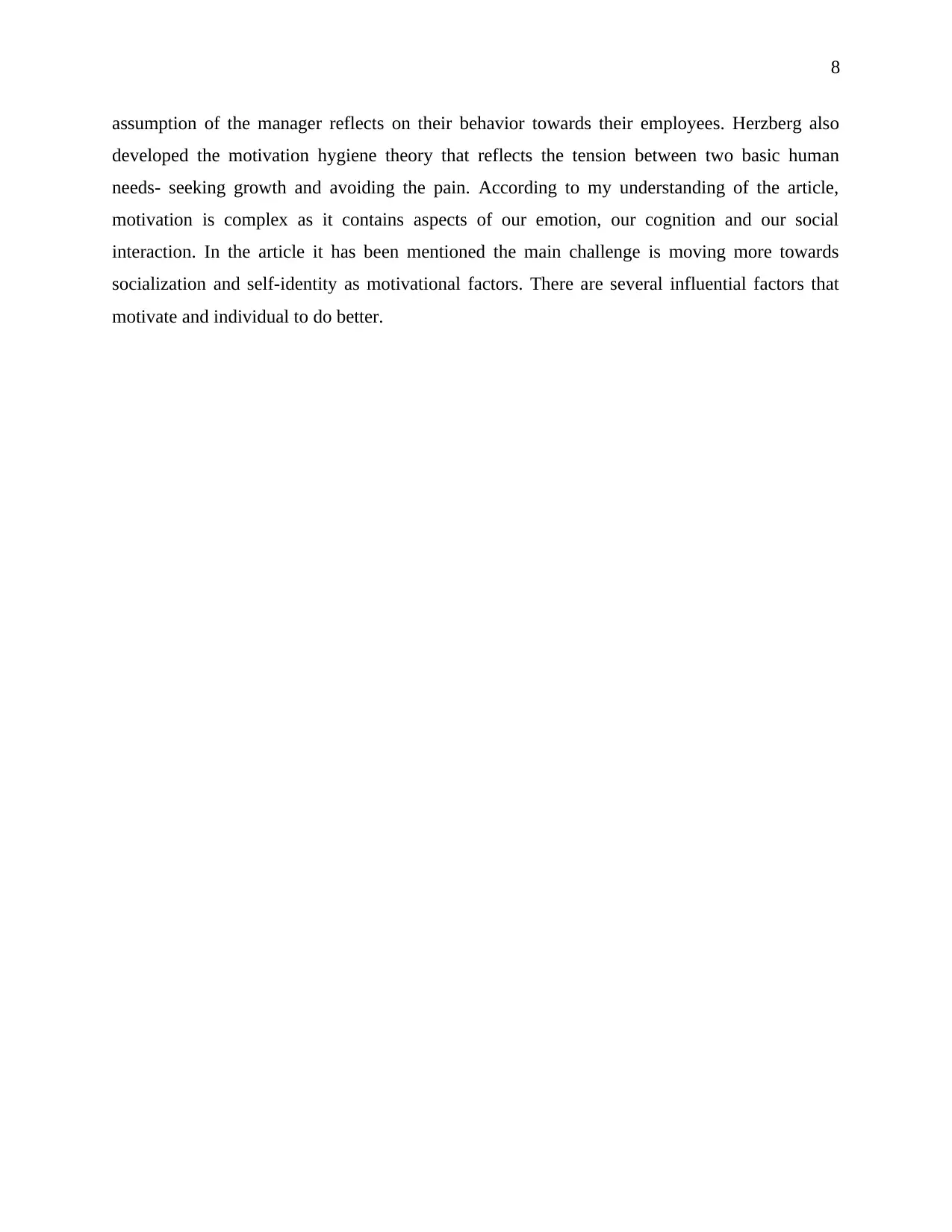
8
assumption of the manager reflects on their behavior towards their employees. Herzberg also
developed the motivation hygiene theory that reflects the tension between two basic human
needs- seeking growth and avoiding the pain. According to my understanding of the article,
motivation is complex as it contains aspects of our emotion, our cognition and our social
interaction. In the article it has been mentioned the main challenge is moving more towards
socialization and self-identity as motivational factors. There are several influential factors that
motivate and individual to do better.
assumption of the manager reflects on their behavior towards their employees. Herzberg also
developed the motivation hygiene theory that reflects the tension between two basic human
needs- seeking growth and avoiding the pain. According to my understanding of the article,
motivation is complex as it contains aspects of our emotion, our cognition and our social
interaction. In the article it has been mentioned the main challenge is moving more towards
socialization and self-identity as motivational factors. There are several influential factors that
motivate and individual to do better.
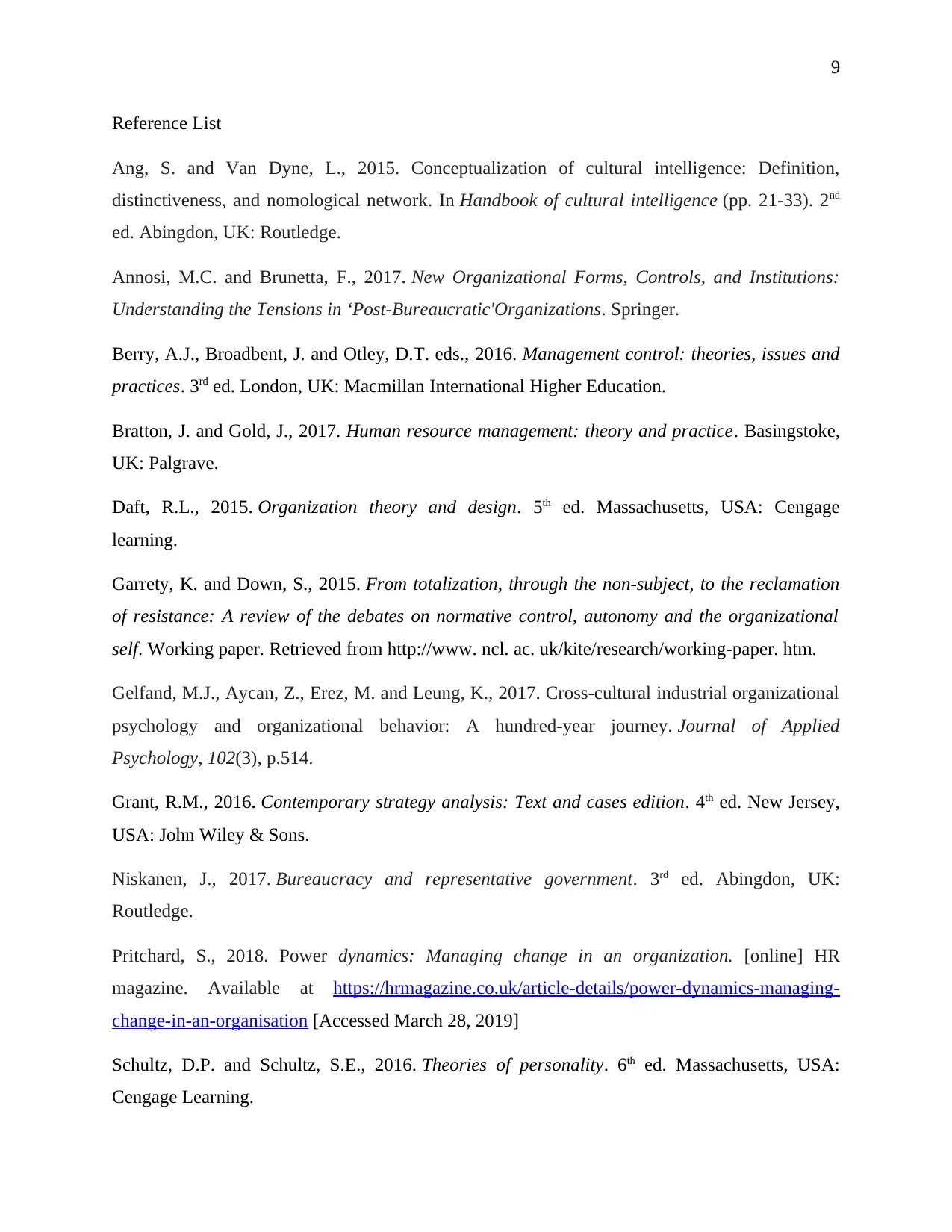
9
Reference List
Ang, S. and Van Dyne, L., 2015. Conceptualization of cultural intelligence: Definition,
distinctiveness, and nomological network. In Handbook of cultural intelligence (pp. 21-33). 2nd
ed. Abingdon, UK: Routledge.
Annosi, M.C. and Brunetta, F., 2017. New Organizational Forms, Controls, and Institutions:
Understanding the Tensions in ‘Post-Bureaucratic'Organizations. Springer.
Berry, A.J., Broadbent, J. and Otley, D.T. eds., 2016. Management control: theories, issues and
practices. 3rd ed. London, UK: Macmillan International Higher Education.
Bratton, J. and Gold, J., 2017. Human resource management: theory and practice. Basingstoke,
UK: Palgrave.
Daft, R.L., 2015. Organization theory and design. 5th ed. Massachusetts, USA: Cengage
learning.
Garrety, K. and Down, S., 2015. From totalization, through the non-subject, to the reclamation
of resistance: A review of the debates on normative control, autonomy and the organizational
self. Working paper. Retrieved from http://www. ncl. ac. uk/kite/research/working-paper. htm.
Gelfand, M.J., Aycan, Z., Erez, M. and Leung, K., 2017. Cross-cultural industrial organizational
psychology and organizational behavior: A hundred-year journey. Journal of Applied
Psychology, 102(3), p.514.
Grant, R.M., 2016. Contemporary strategy analysis: Text and cases edition. 4th ed. New Jersey,
USA: John Wiley & Sons.
Niskanen, J., 2017. Bureaucracy and representative government. 3rd ed. Abingdon, UK:
Routledge.
Pritchard, S., 2018. Power dynamics: Managing change in an organization. [online] HR
magazine. Available at https://hrmagazine.co.uk/article-details/power-dynamics-managing-
change-in-an-organisation [Accessed March 28, 2019]
Schultz, D.P. and Schultz, S.E., 2016. Theories of personality. 6th ed. Massachusetts, USA:
Cengage Learning.
Reference List
Ang, S. and Van Dyne, L., 2015. Conceptualization of cultural intelligence: Definition,
distinctiveness, and nomological network. In Handbook of cultural intelligence (pp. 21-33). 2nd
ed. Abingdon, UK: Routledge.
Annosi, M.C. and Brunetta, F., 2017. New Organizational Forms, Controls, and Institutions:
Understanding the Tensions in ‘Post-Bureaucratic'Organizations. Springer.
Berry, A.J., Broadbent, J. and Otley, D.T. eds., 2016. Management control: theories, issues and
practices. 3rd ed. London, UK: Macmillan International Higher Education.
Bratton, J. and Gold, J., 2017. Human resource management: theory and practice. Basingstoke,
UK: Palgrave.
Daft, R.L., 2015. Organization theory and design. 5th ed. Massachusetts, USA: Cengage
learning.
Garrety, K. and Down, S., 2015. From totalization, through the non-subject, to the reclamation
of resistance: A review of the debates on normative control, autonomy and the organizational
self. Working paper. Retrieved from http://www. ncl. ac. uk/kite/research/working-paper. htm.
Gelfand, M.J., Aycan, Z., Erez, M. and Leung, K., 2017. Cross-cultural industrial organizational
psychology and organizational behavior: A hundred-year journey. Journal of Applied
Psychology, 102(3), p.514.
Grant, R.M., 2016. Contemporary strategy analysis: Text and cases edition. 4th ed. New Jersey,
USA: John Wiley & Sons.
Niskanen, J., 2017. Bureaucracy and representative government. 3rd ed. Abingdon, UK:
Routledge.
Pritchard, S., 2018. Power dynamics: Managing change in an organization. [online] HR
magazine. Available at https://hrmagazine.co.uk/article-details/power-dynamics-managing-
change-in-an-organisation [Accessed March 28, 2019]
Schultz, D.P. and Schultz, S.E., 2016. Theories of personality. 6th ed. Massachusetts, USA:
Cengage Learning.
⊘ This is a preview!⊘
Do you want full access?
Subscribe today to unlock all pages.

Trusted by 1+ million students worldwide
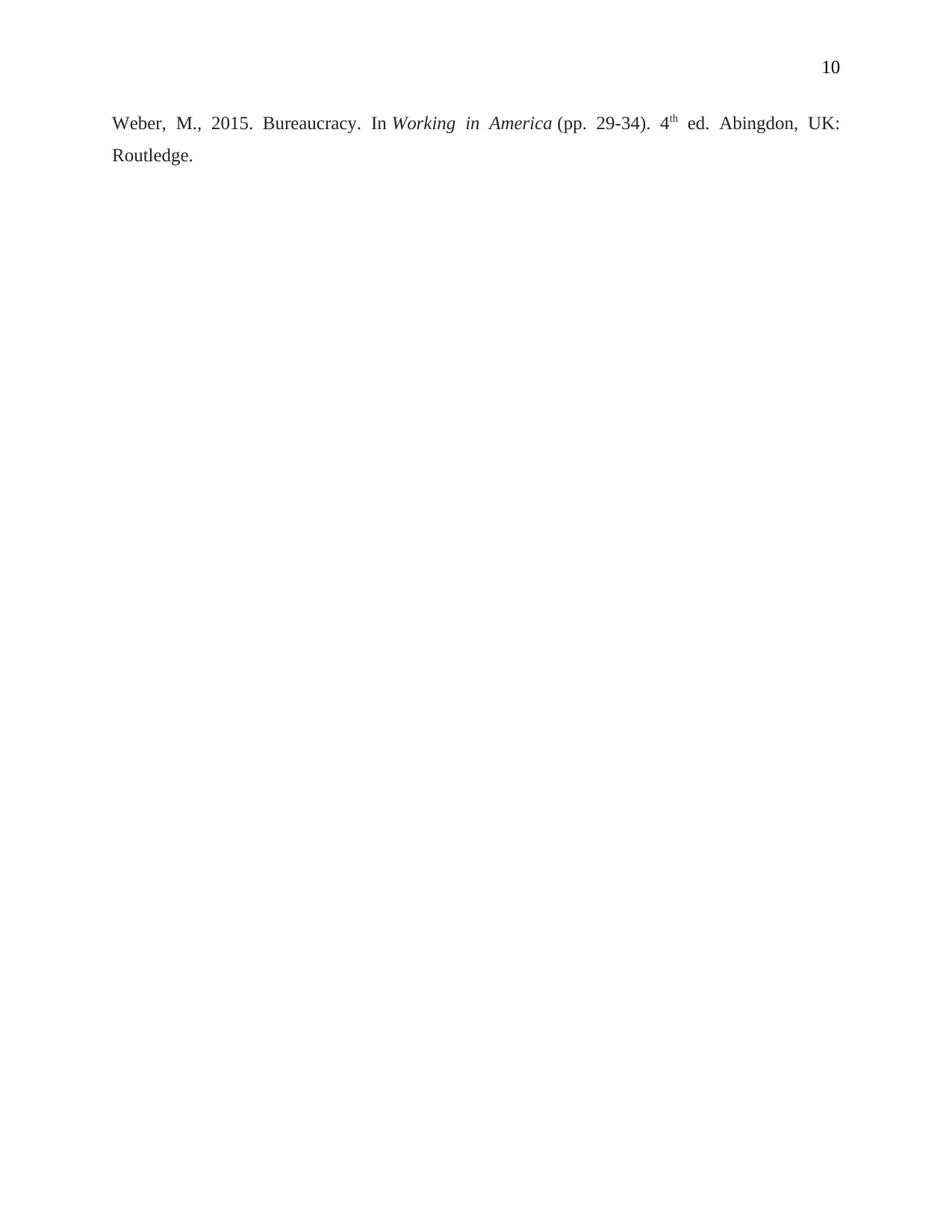
10
Weber, M., 2015. Bureaucracy. In Working in America (pp. 29-34). 4th ed. Abingdon, UK:
Routledge.
Weber, M., 2015. Bureaucracy. In Working in America (pp. 29-34). 4th ed. Abingdon, UK:
Routledge.
1 out of 10
Related Documents
Your All-in-One AI-Powered Toolkit for Academic Success.
+13062052269
info@desklib.com
Available 24*7 on WhatsApp / Email
![[object Object]](/_next/static/media/star-bottom.7253800d.svg)
Unlock your academic potential
Copyright © 2020–2025 A2Z Services. All Rights Reserved. Developed and managed by ZUCOL.





